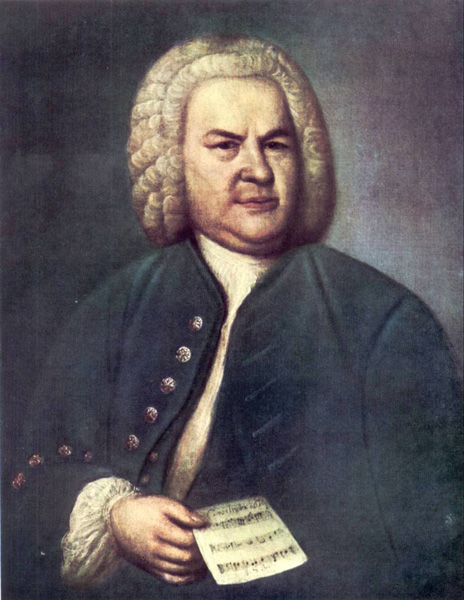In Celebration of the Human Voice - The Essential Musical Instrument
Home | Doo Wop | Barbershop | World | Contemporary | Christian | Vocal Jazz | Choral | Christmas | Instructional | Arrangements
Classical | Opera | Musicals | Personality | Young Singers | Disney | Videos | Songs | The Artists

Johann Sebastian Bach Biography

Click Here for Sheet Music and Songbook Vocal Arrangements
Born into a musical family, Bach received his earliest instruction from his father. After his father's death in 1695, Bach moved to Ohrdruf, where he lived and studied organ with his older brother Johann Christoph. He also received an education at schools in Eisenach, Ohrdruf, and Luneburg. Bach's first permanent positions were as organist in Arnstadt (1703-1707) and Muhlhausen (1707-1708). During these years, he performed, composed taught, and developed an interest in organ building. From 1708-1717 he was employed by Duke Wilhelm Ernst of Weimar, first as court organist, and after 1714, as concertmaster. During this period, he composed many of his best organ compositions; in his capacity as concertmaster, he was also expected to produce a cantata each month. In Weimar, Bach's style was influenced by his study of numerous Italian compositions (especially Vivaldi concertos). Bach's next position, as Music Director for the Prince Leopold of Cuthen (1717-1723), involved entirely different activities. Since the court chapel was Calvinist, there was no need for church compositions; Bach probably used the Cuthen organs only for teaching and practice. His new works were primarily for instrumental solo or ensemble, to be used as court entertainment or for instruction. Among the important compositions at Cuthen were the Brandenburg Concertos, the first volume of Das wohltemperirte Clavier (The Well-Tempered Clavier), the "French" and "English" Suites for harpsichord (although the "English" Suites may be from the Weimar period), and most of the sonatas and suites for other instruments. Bach also composed a few cantatas for special occasions (birthdays and New Years). In 1723, Bach was appointed cantor at the St. Thomas Church and School, and Director of Music for Leipzig, positions which he retained for the rest of his career. His official duties included the reponsibility of overseeing the music in the four principal churches of the city, and organizing other musical events sponsored by the municipal council. For these performances, he used pupils from the St. Thomas School, the city's professional musicians, and university students. Bach divided his singers into four choirs (one for each of the four main churches); he personally conducted the first choir, which sang on alternate Sundays at St. Thomas and St. Nicholas. His usual performing group consisted of around sixteen singers and eighteen instrumentalists, although these numbers could be augmented for special occasions. During his first six years in Leipzig (1723-1729), Bach's most impressive compositions were his sacred cantatas (four yearly cycles), and the St. John and St. Matthew Passions. Bach apparently gave virtuoso organ recitals in Leipzig and on various tours, although he had no official position as organist in Leipzig. After 1729 Bach no longer concentrated so completely on composing sacred vocal music. For services, he re-used his own substantial repertory of cantatas, and turned increasingly to the music of his contemporaries. In 1729-1737 and 1739-1741, he was director of the Leipzig Collegium Musicum, an organization which had been founded by Telemann in 1704. This group of professional musicians and university students performed weekly concerts (out-of-doors in the summer, and at Zimmerman's coffee-house in the winter). Although no specific programs for these concerts have survived, Bach apparently revived and many of his instrumental compositions from Cuthen, wrote new works (e.g., secular cantatas), and conducted pieces by other composers. During the 1730s, Bach renewed his interest in keyboard compositions, and prepared the first three volumes of his Clavier-Ubung (Keyboard Practice) for publication (1731, 1735, 1739); the fourth volume appeared in 1741-1742. In the 1730s, he also showed considerable interest in the royal court at Dresden, and was named "Hofkomponist" (court-composer") in Dresden in 1736. During Bach's last decade (the 1740s), he completed or revised several large-scale projects which he had started earlier. The Well-Tempered Clavier, Vol. II; a manuscript collection of chorale preludes (known as the "Leipzig 18", comprising revisions of Weimar pieces), and the B minor Mass. Other new works showed an increased interest in fugal and canonic writing: Musikalische Opfer (Musical Offering); the canonic variations for organ on "Vom Himmel hoch"; and Die Kunst der Fuge ( The Art of Fugue). In the 1740s, Bach made various journeys, most notably to the court of Frederick the Great in 1747. He continued a lively interest in the building of organs, and kept informed about the latest developments in the construction of harpsichords and pianofortes. |
Select a Category |
Want to Sing? - Find a Chorus Near You
List of Choruses by State | List of Choruses by City
